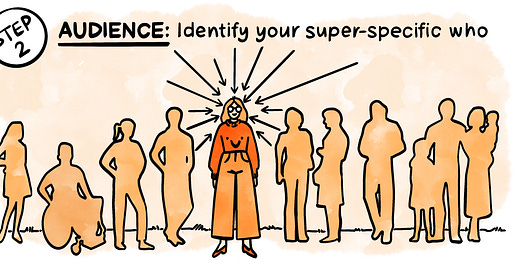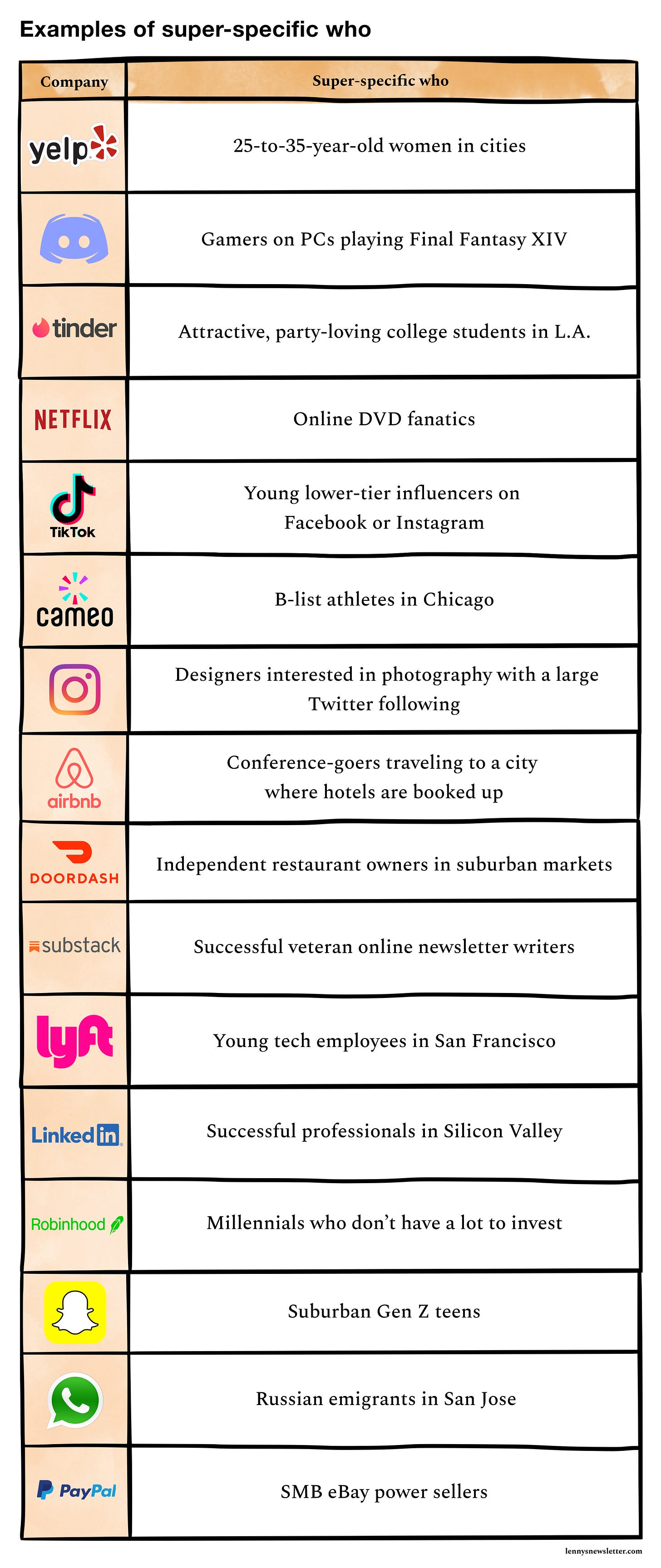How to kickstart and scale a consumer business—Step 2: Identify your super-specific who
Lessons from Substack, Netflix, Yelp, Discord, TikTok, Instagram, Cameo, DoorDash, and dozens of others
👋 Hey, I’m Lenny and welcome to a 🔒 subscriber-only edition 🔒 of my weekly newsletter. Each week I tackle reader questions about product, growth, working with humans, and anything else that’s stressing you out about work. Send me your questions and in return I’ll humbly offer actionable real-talk advice.
Welcome to part two of our six-part series on kickstarting and scaling a consumer business. If you’re just joining us, here are links to previous posts, and a sense of what’s ahead:
Step 2: AUDIENCE: Identify your super-specific who ←This post
Step 4: REACH: Find your early adopters by doing things that don’t scale
The main question we’ll be answering in today’s post: Why (and how) do you target a very narrow set of early adopters?
Let’s get right into it.
In January 2010, when Ben Silbermann launched Pinterest, his initial growth strategy was to target his techie friends. He first emailed friends to let them know about his new site that lets you organize and share the things you love. “What’s the point?” they all asked. He then emailed all of his co-founders’ friends on the East Coast. No one cared. He emailed everybody he knew from his last job at Google, and all of his wife’s friends at Facebook.
“No one really got it, to be totally honest with you. But they were also very polite about it. ‘This looks interesting. Very interesting,’ they’d say.”
He then started spending time at Apple stores, where he switched the default home pages on every laptop to Pinterest.com and stood in the back saying, “Wow! This Pinterest thing is really blowing up.” Didn’t work.
Ben started to realize that maybe tech people had no interest in what he was building. But there was an unexpected demographic that seemed to get it, as Ben shared at a talk at Startup School:
“There was a small group of people who were really enjoying it. Those folks would not be who you’d think of stereotypically as early adopters. They were folks I grew up with. People that were using it for regular life stuff: What is my house going to look like? What kind of food do I want to eat?”
On a whim, Ben decided to attend a conference in Salt Lake City called Alt Summit, a large female-focused design and blogging conference. He walked the halls pitching Pinterest and began to see a bit of interest. Eventually he met a woman named Victoria Smith who had a blog called SFGirlByBay. She quickly saw the potential of Pinterest, and they decided to collaborate on a promotion: Victoria created a Pinterest board with all the things that mean “home” to her and then tagged other bloggers to do the same. Each blog had a small but rabid fan base, and their audiences loved it. They got Pinterest. Soon they started to use it for all kinds of other things, and just a year later, Pinterest was at over a million users.
Throughout this journey, the product itself didn’t meaningfully change—the audience did. Ben initially assumed that a new tech website would resonate with tech employees. Instead, 30-something female bloggers turned out to be the ideal early adopters.
When deciding who to go after when just starting out, it’s important to be super-specific. You need to find your “super-specific who”.
As Andy Johns (former growth leader at Facebook, Twitter, Wealthfront, and Quora) put it:
“When it comes to the question of the target customer, the most common mistake is the definition is too broad. It must be almost comically narrow, to the point where you may be misunderstood for such a narrow focus.
At Wealthfront, our initial target customer was an engineer at a pre-IPO tech company, typically between 25 and 35 years old, less than $1M net worth, and had a personal preference to delegate money management to a trusted third party.”
Michael Seibel shared the same lesson from his time at Justin.TV (60-second clip):
As did Andy Rachleff (co-founder of Benchmark):
“If you want to build a big business, you don’t go after the big market first, because those people only buy based on references, and you don’t have the references. You need to create a beachhead, a niche you can dominate. Through references, you grow from that niche of early adopters.”
As did Paul Graham:
“Usually your initial group of users is small, for the simple reason that if there were something that large numbers of people urgently needed and that could be built with the amount of effort a startup usually puts into a version one, it would probably already exist.”
April Dunford (author of Obviously Awesome) calls this your “customers who care”:
“There is likely a wide range of buyers that care about that value, but certain customers care a lot more than others. What are the characteristics of a customer that makes them care a lot about your differentiated value? That gives us an idea of who our best-fit customers are. Your best-fit target customers are customers that really care a lot about your unique value.”
And Julie Supan (GTM advisor to YouTube, Airbnb, Dropbox, Discord, and Thumbtack) calls this your “high-expectation customer”:
“The high-expectation customer, or HXC, is the most discerning person within your target demographic. It’s someone who will acknowledge—and enjoy—your product or service for its greatest benefit.
They look things up. They research things. And they have ideas for new types of products or services that can help them save money, gain time, get healthier, or make their team more productive. If your product exceeds their expectations, it can meet everyone else’s.”
Nearly every successful consumer company nailed their super-specific who (though not always right away). Here are a bunch of examples:
How they found their super-specific who
Yelp started very broad and quickly found one specific group that was most drawn to its product:
“Early on, we found that females ages 25 to 35 were the most active Yelp users. It’s not because we chose to focus on them—more like that’s who Yelp most strongly resonated with in the early months. We were neutral in our initial outreach (just friends and friends of friends), and then the first super-active users who had happened to be in that demographic—a disproportionate amount of 25-to-35 females. It was more just an observation of who it resonated with than an a priori idea we came in with.”
—Russel Simmons, co-founder and ex-CTO of Yelp
Cameo started off by focusing on B-list athletes because the idea itself was inspired by one—and it turned out to be a great target:
“The way the company started was Steven and Martin were chatting at a funeral, and Martin was talking about how he recently became an NFL agent, managing Cassius Marsh, and was trying to find him brand deals. They decided to start a company where for X dollars you can do Y activity with Z athlete—for example, go golfing with Michael Jordan, invite Serena Williams to your daughter’s birthday, etc.
This evolved into what Cameo is today, starting with Cassius and some former Duke athletes we knew. We quickly went into additional verticals, but now that we’ve had time to tune the platform and develop the brand, athletes are again one of our strongest verticals.”
—Devon Townsend, co-founder and CTO of Cameo
Netflix went after online DVD fanatics because that’s who they suspected would benefit most from unlimited DVD rentals:
“[We’d] realized, early on, that the only way to find DVD owners was in the fringe communities of the internet: user groups, bulletin boards, web forums, and all of the other digital watering holes where enthusiasts met up.”
—Marc Randolph, co-founder of Netflix, from That Will Never Work
Instagram went after designers interested in photography with a large Twitter following, because those are the people they wanted to set the tone for the platform:
“The founders picked their first users carefully, courting people who would be good photographers—especially designers who had high Twitter follower counts. Those first users would help set the right artistic tone, creating good content for everyone else to look at, in what was essentially the first-ever Instagram influencer campaign, years before that would become a concept.”
—Kevin Systrom, co-founder and CEO
Wealthfront went after young engineers at pre-IPO tech companies:
“We started with young people in tech and we started with engineers in tech, and then they told the product managers and the biz dev people and the salespeople and then they told their friends who they went to college with and might be lawyers or doctors. They told their friends about it locally and then they told their friends about it nationally and they just kept growing through word of mouth.
We also learned that employees of enterprise software companies were not good targets because they were older than people who worked at consumer internet companies.”
—Andy Rachleff, co-founder
Discord’s super-specific who was comically narrow:







